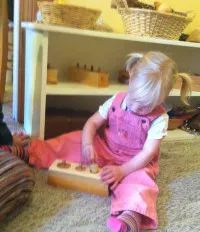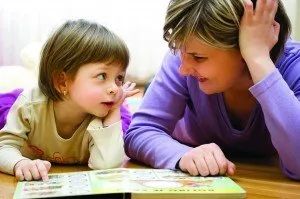Human Needs and Tendencies
Know How to Go with the Flow
Maria Montessori observed that all children, regardless of race or culture, follow certain patterns of behavior or “tendencies” as they grow and develop. She concluded, after much research in the field of anthropology, that these behavioral patterns have been consistent throughout the history of mankind. Children, and indeed human beings, are hard-wired to use common behaviors to get their basic needs met.
Trying to make a child to work against his or her inner fluxes can be a lot like trying to swim upstream.

Teachers and parents can benefit enormously from the understanding of these deeply ingrained behaviors. Children acting in synchronicity with their natural tendencies are internally motivated and fulfilled. Whereas, trying to make a child to work against his or her inner fluxes can be a lot like trying to swim upstream…in the Amazon…with your hands tied behind your back!
The way the Montessori Method helps children to meet their needs is based on an in-depth understanding of these human tendencies. They are (as defined by Maria Montessori):
- Exploration
- Orientation
- Order
- Imagination
- Manipulation of objects
- Repetition
- Precision
- Control of error leading to perfection
- Communication
 Newborn babies are soaking in the sights, sounds, smells, tastes, and textures of everything around them.
Newborn babies are soaking in the sights, sounds, smells, tastes, and textures of everything around them.

Exploration—If you have spent any time around children, you know that they are continually exploring with their senses. Newborn babies are soaking in the sights, sounds, smells, tastes, and textures of everything around them. As they gain motor control, these explorations become more and more active. Teachers and parents must provide a safe, sensory rich environment for children to explore.
Orientation—Humans have a basic need to know where they are in relation to their surroundings. When children explore, they want to know where they can go and how to get back. From these basic orientation skills, children learn to navigate their way through life, both physically and socially.
Humans need two types of order: internal and external.

Order—Humans need two types of order: internal and external. By providing an orderly classroom or environment, adults can help the child develop a sense of internal order. Order brings security; children know what to expect and when to expect it. Children must internalize the idea of order to help them learn concepts such as sequence, sorting, and logical thinking.
Imagination--Sometimes called “abstraction,” to imagine is to visualize something not yet there. Children can imagine things in their minds and then create them if they have the right tools and the freedom to express what they’re visualizing. Painting, crafting, drawing, music, and storytelling are all constructive ways for children to use their imaginations.
 Children are born with an innate need to touch, hold, and shape their environment.
Children are born with an innate need to touch, hold, and shape their environment.

Manipulation of objects—The word manipulation comes from the Latin word manus, meaning hands. Human beings literally need to handle objects to understand them. Children are born with an innate need to touch, hold, and shape their environment. Children learn to use manipulation in conjunction with exploration and their expression of imagination.
Repetition—Children have within them a need to repeat certain tasks over and over again. They are working toward mastery of that task. Maria Montessori teaches us that this repetition is complete only when the child decides they are finished. When a child is engaged in repetition, he or she will often be very focused. This leads, not only to mastery of the task, but also to a heightened ability to concentrate and a sense of accomplishment.
Precision—Human beings tend to seek exactness or precision. Children have an innate tendency to seek “perfection” in their work. They use other tendencies such as manipulation of objects, order, and repetition to achieve a satisfying sense of exactness.
“Sometimes very small children in a proper environment develop a skill and exactness in their work that can only surprise us.” ~Maria Montessori
Control of error leading to perfection—Here we see the all of the tendencies work together. The child explores his environment and is drawn to a certain material or task. He manipulates the materials. He imagines what he would like the outcome to be. He repeats the manipulations seeking order and precision. He is not satisfied until he feels he has achieved exactness. He controls his own error by noticing imperfections. He continues to work, striving for “perfection.” This idea of perfection is in the mind of the child, not something assigned by a parent or teacher. Children experience a deep sense of satisfaction and joy when they are allowed to work until they have achieved what they feel is perfection.
 Children use facial expressions, gestures, and speech to communicate their basic needs.
Children use facial expressions, gestures, and speech to communicate their basic needs.

Communication—communication makes it possible for humans to share their inner thoughts and feelings. It is also the way we pass information from one individual to the next. Children use facial expressions, gestures, and speech to communicate their basic needs. Ultimately, the child’s tendency toward communication leads him to the written word and reading.
The underlying tendencies that drive human behavior are everywhere, in every culture and throughout time. Once we become aware of these tendencies, we can encourage children to follow their own, inner motivations. Self-motivated children are far more calm, focused, and satisfied than those being steered against their inner currents.
“Once we recognize these universal tendencies, the question becomes, how can we facilitate and nurture their natural unfolding? Precisely because these tendencies became evident to Maria Montessori, their unfolding is observed, respected, and nurtured in the well-run Montessori classroom.” ~ Excerpt from Age of Montessori’s online Child Development Course.




















